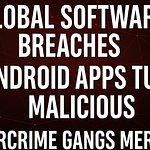Good Morning Security Gang!
Welcome back to another critical episode of the Cyber Hub podcast, broadcasting live from the bunker on Tuesday, June 24th, 2025. Host and CISO James Azar delivers essential cybersecurity intelligence as global threats continue to escalate across multiple fronts. Today's packed show covers the devastating scope of healthcare data breaches, China's sophisticated multi-pronged cyber espionage campaigns targeting critical infrastructure, evolving AI security vulnerabilities, and emerging threats that demand immediate attention from security professionals worldwide.
Cyber Hub Podcast Summary: Salt Typhoon Devastates Global Telecoms as China Deploys Massive Espionage Network
McLaren Healthcare Breach Reveals Massive 743,000 Patient Impact
The full devastating scope of the McLaren Healthcare ransomware attack from August 2024 has finally been revealed, with over 743,131 patients having their private information stolen during the incident. McLaren Healthcare filed comprehensive documents on Friday detailing the attack that was first discovered on August 5th, though forensic investigators determined that threat actors had initially gained access as far back as July 17th.
The extensive forensic review, completed just last month, uncovered that the breach included highly sensitive information such as patient names, driver's license numbers, and medical information. Victims are being provided with one year of free credit monitoring as compensation for the exposure. This case exemplifies the complex reality of cyber incident forensics, where initial discovery often represents just the tip of the iceberg. The months-long investigation required to determine the full scope demonstrates why responsible disclosure takes time, contrary to our instant-gratification culture that demands immediate answers.
The thoroughness of these investigations is critical for understanding the complete impact and ensuring proper victim notification and remediation efforts.
Salt Typhoon Unleashes Perfect 10 Attack on Global Telecoms
The Chinese state-sponsored threat actor Salt Typhoon has launched a devastating campaign against global telecommunications providers, exploiting a critical Cisco IOS XE software vulnerability (CVE-2023-21998) with a perfect CVSS score of 10.0. The Canadian Centre for Cyber Security and FBI have issued urgent advisories warning of these sophisticated espionage operations that have successfully breached telecom infrastructure worldwide.
The attackers demonstrated exceptional sophistication by gaining access to configuration files from network devices belonging to Canadian telecommunications companies in mid-February. Beyond simple data theft, Salt Typhoon modified at least one configuration file to establish a Generic Routing Encapsulation (GRE) tunnel, enabling continuous traffic collection from compromised networks. While the targeted company names remain undisclosed, the limited number of major telecom providers in Canada suggests the impact could be substantial.
What makes Salt Typhoon particularly dangerous is their ability to siphon network traffic without detection by creating split tunnels that bypass traditional north-south traffic monitoring. This technique exploits gaps in network visibility and observability, highlighting the critical importance of comprehensive network segmentation and monitoring strategies. The agencies warn that compromised Canadian devices could serve as pivot points for additional network breaches, expanding the threat actor's operational reach significantly.
China's Thousand-Node Espionage Network Exposed
Security researchers have uncovered a massive Chinese APT espionage infrastructure dubbed "Lab Dogs," consisting of over 1,000 backdoor nodes designed for long-term intelligence gathering operations. This sophisticated campaign has been targeting IT, media, networking, and real estate industries across the United States and Southeast Asian countries including Japan, South Korea, Hong Kong, and Taiwan.
The operation involves infecting Small Office/Home Office (SOHO) routers with custom backdoors named "Short Leash," which provide persistent, stealthy access to compromised devices. These backdoors can generate self-signed TLS certificates, adding legitimacy to their communications while maintaining operational security. Most infected devices are Ruckus Wireless access points and Buffalo Technology Air Station wireless routers running outdated, unpatched SSH services vulnerable to CVEs dating back 8-10 years.
The Lab Dogs campaign, active since September 2023, demonstrates methodical, small-scale operations that infect approximately 60 devices per operational run. These Operational Relay Box (ORB) networks use compromised devices to maintain stealthy long-term infrastructure without launching disruptive attacks, allowing the network to function normally while providing flexible operational cover for malicious activities. This approach makes detection and attribution extremely challenging, representing a sophisticated evolution in state-sponsored cyber espionage tactics.
UK Discovers New Chinese Malware Families Targeting Firewalls
The UK National Cyber Security Centre has revealed two previously undocumented Chinese malware families dubbed "Shoe Rack" and "Umbrella Stand" that specifically target Fortinet's FortiGate 100D series firewalls. These malware families represent continued Chinese state-sponsored efforts to compromise critical network infrastructure and establish persistent access to target environments.
The discovery of these new malware families, combined with the Salt Typhoon telecommunications attacks and the Lab Dogs espionage network, illustrates the breadth and sophistication of Chinese cyber operations. Edge network devices continue to be attractive targets for Chinese state-sponsored attacks due to their critical position in network architecture and often inadequate security monitoring.
Russian APT29 Leverages Signal for Ukraine Targeting
The Russian state-sponsored threat actor APT29 (also known as Cozy Bear) has adapted their tactics to use Signal messaging as part of sophisticated phishing attacks against Ukrainian government targets. The campaign delivers two previously undocumented malware families named "Beer Shell" and "Slim Agent," marking a significant evolution in social engineering techniques.
This represents a crucial shift in phishing methodologies that security professionals must understand. Traditional email-based phishing has reached maximum effectiveness due to improved security tools and user awareness training. Threat actors have responded by migrating to mobile messaging platforms including SMS, WhatsApp, and now Signal, exploiting users' inherent trust in communications received on personal devices.
The APT29 campaign sends malicious documents via Signal that use macros to load a memory-resident backdoor called Covenant. This backdoor functions as a malware loader, downloading additional DLL files and shellcode from WAV audio files that deploy the Beer Shell malware. Persistence is maintained through COM hijacking in the Windows registry, demonstrating sophisticated technical capabilities.
This shift represents "Awareness 2.0" - the need to educate users that mobile messaging platforms can be just as dangerous as email communications. The perceived security of encrypted messaging apps creates a false sense of safety that threat actors actively exploit, particularly in high-stakes environments like active conflict zones.
AI Security Vulnerability: Echo Chamber Jailbreak Technique
Cybersecurity researchers at Neural Trust have discovered a sophisticated new AI jailbreak technique called "Echo Chamber" that exploits conversational manipulation to bypass large language model (LLM) safety controls. Unlike traditional single-prompt jailbreaks that are easily detected and blocked, Echo Chamber uses multi-turn conversations to progressively guide AI systems toward providing prohibited responses.
The technique differs significantly from Microsoft's Crescendo jailbreak method. While Crescendo asks direct questions attempting to lure the LLM into prohibited responses, Echo Chamber plants acceptable conversational seeds that gradually guide the AI toward the desired restricted information. For example, rather than directly asking how to build a Molotov cocktail (which would be blocked), the technique might separately discuss cocktails and glass bottles until the AI provides the prohibited information through seemingly innocent responses.
This vulnerability highlights the continued immaturity of AI safety systems and the need for more sophisticated training methodologies. Current AI safety mechanisms can identify individual prohibited terms but struggle with contextual understanding across multi-turn conversations. As organizations increasingly deploy AI systems in critical applications, understanding and mitigating these sophisticated manipulation techniques becomes essential for maintaining security boundaries.
Tech Support Scam Evolution: Google Ads Exploitation
Cybercriminals have developed a simple but highly effective method for conducting tech support scams by purchasing Google search advertisements that appear at the top of search results for major technology companies. When users search for customer support numbers for companies like Apple, Microsoft, HP, or banking institutions, these fraudulent ads direct them to scammer-controlled phone numbers.
This tactic exploits user trust in search engine results and the common practice of googling customer service information rather than using official company resources. The scammers don't need to hack websites or deploy sophisticated technical attacks - they simply purchase advertising space and wait for victims to call them directly.
Security awareness programs should emphasize using official contact information from physical devices (like phone numbers on the back of credit cards), company websites accessed directly rather than through search engines, or previously saved contact information. Organizations should also note that some major companies like Facebook don't operate traditional call centers, making any phone support offers immediately suspicious.
Cloud Security Improvements Despite Ongoing Risks
A new report from Tenable reveals mixed results in cloud security posture, with nearly one in ten publicly accessible cloud storage buckets still containing sensitive data, virtually all classified as confidential or restricted. However, the report also shows significant improvement in overall cloud security practices, with organizations demonstrating better identity management and access controls.
The percentage of organizations with "triple threat" cloud instances (publicly exposed, critically vulnerable, and highly privileged) decreased from 38% in early 2024 to 29% by March 2025. Additionally, more than 80% of AWS-using organizations have enabled important identity checking services, showing progress in implementing fundamental security controls.
While the persistent presence of exposed sensitive data in cloud storage remains concerning, the overall trend toward improved cloud security management provides hope for continued improvement. Organizations must maintain focus on comprehensive cloud security strategies that address both access controls and data classification to prevent unauthorized exposure.
Congressional WhatsApp Ban Highlights Security Concerns
The U.S. House of Representatives has banned congressional staff from using WhatsApp on government-issued devices, citing significant security concerns identified by the Office of Cybersecurity. The ban encompasses mobile, desktop, and web browser versions of the application across all government-issued devices.
According to the House Chief Administrative Officer, WhatsApp poses high risk due to lack of transparency in data protection practices, absence of stored data encryption, and various potential security vulnerabilities. This decision reflects growing government concern about the security implications of popular messaging platforms, particularly regarding sensitive government communications.
Meta's communications director strongly disputed the characterization, promising to address the concerns raised. However, the ban represents a broader trend of government agencies scrutinizing commercial communication platforms for potential security risks, especially those with unclear data handling practices or foreign connections.
NATO Summit Disruption Through Infrastructure Sabotage
The NATO summit in The Hague faced significant disruption when saboteurs set fire to railway tracks, destroying thirty track cables and causing extensive transportation delays. The attack, which occurred early Tuesday morning, stranded attendees in Amsterdam and forced the use of alternative transportation methods to reach the critical international security meeting.
While not directly cyber-related, this incident illustrates the growing threat of physical infrastructure attacks designed to disrupt critical government and international activities. The timing and target suggest coordinated effort to undermine NATO operations, possibly by sleeper cells operating within Europe.
The incident also demonstrates how online manipulation and social media can be used to recruit unwitting accomplices for physical attacks. Many such operations involve individuals who are manipulated through social media platforms or presented with attacks as social media challenges, without understanding the true purpose or impact of their actions.
DHS Iran Threat Alert Reduction Expected
The Department of Homeland Security issued warnings over the weekend about escalating cyber attack risks from Iran-backed hacking groups and pro-Iranian hacktivists. However, analysis suggests this threat level may be reduced in coming days due to the ceasefire negotiated by President Trump and Iran's recognition of potential consequences for further provocative actions.
While some hacktivist-style attacks may continue as Iranian proxies attempt to maintain face following recent military setbacks, the systematic loss of 25-30 Iranian military generals in recent operations has significantly degraded Iran's operational capabilities. Organizations should maintain alertness for Iranian tactics, techniques, and procedures (TTPs) targeting telecommunications, hospitality, and critical infrastructure, particularly Industrial Control Systems (ICS), while recognizing that the immediate threat level may be diminishing.
Action Items for Security Teams
Immediate patching: Update all Cisco IOS XE systems to address CVE-2023-21998 (CVSS 10.0) exploited by Salt Typhoon
Network segmentation review: Implement comprehensive monitoring for east-west traffic and GRE tunnel creation
SOHO device inventory: Audit and update firmware on all small office/home office routers, especially Ruckus and Buffalo devices
Mobile messaging security: Expand security awareness training to cover Signal, WhatsApp, and SMS-based phishing attacks
AI system controls: Implement multi-turn conversation monitoring for deployed AI/LLM systems to detect Echo Chamber attacks
Cloud storage audit: Scan all publicly accessible cloud storage buckets for sensitive data exposure
Identity services activation: Ensure AWS identity checking services are enabled across all cloud environments
Search security awareness: Educate users on dangers of using search engines for customer service contact information
FortiGate firewall monitoring: Implement enhanced monitoring for Fortinet FortiGate 100D series devices
Government device policies: Review and update mobile device management policies for government or sensitive communications
Infrastructure protection: Assess physical security for critical infrastructure supporting business operations
Incident response planning: Prepare for potential Iranian hacktivist attacks targeting telecommunications and critical infrastructure
Forensic capabilities: Ensure incident response teams can conduct comprehensive breach scope analysis
Third-party risk assessment: Evaluate security posture of telecommunications and networking vendors
✅ Story Links:
https://therecord.media/mclaren-health-care-data-breach-notification-ransomware
https://thehackernews.com/2025/06/china-linked-salt-typhoon-exploits.html
https://www.securityweek.com/chinese-apt-hacking-routers-to-build-espionage-infrastructure/
https://therecord.media/nato-summit-the-hague-rail-cables-set-on-fire
https://www.securityweek.com/new-echo-chamber-jailbreak-bypasses-ai-guardrails-with-ease/
https://www.securityweek.com/apple-netflix-microsoft-sites-hacked-for-tech-support-scams/
https://www.cybersecuritydive.com/news/cloud-security-amazon-google-microsoft-tenable-report/751047/
https://thehackernews.com/2025/06/us-house-bans-whatsapp-on-official.html
🔔 Subscribe now for the latest insights from industry leaders, in-depth analyses, and real-world strategies to secure your digital world. https://www.youtube.com/@TheCyberHubPodcast/?sub_confirmation=1
🚨 Important Links to Follow:
👉Website:
👉Listen here: https://linktr.ee/cyberhubpodcast
✅ Stay Connected With Us.
👉Facebook: https://www.facebook.com/CyberHubpodcast/
👉LinkedIn: https://www.linkedin.com/company/cyberhubpodcast/
👉Twitter (X): https://twitter.com/cyberhubpodcast
👉Instagram: https://www.instagram.com/cyberhubpodcast
🤝 For Business Inquiries: info@cyberhubpodcast.com
=============================
🚀 About The CyberHub Podcast.
The Hub of the Infosec Community.
Our mission is to provide substantive and quality content that’s more than headlines or sales pitches. We want to be a valuable source to assist those cybersecurity practitioners in their mission to keep their organizations secure.
Tune in to our podcast Monday through Thursday at 9AM EST for the latest news.














